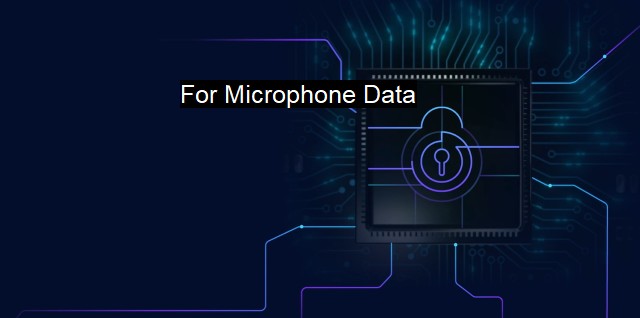What is For Microphone Data?
For Microphone Data (FMD): Understanding Its Significance in Cybersecurity and Anti-Virus Measures
Antivirus and data protection solutions, the concept of "for Microphone Data" bears immense significance with acute concerns about security, privacy, and confidentiality of the data collected via microphones. This term is associated explicitly with the protection of data captured by the microphone of any digital device like computers, laptops, mobile phones, tablets, and other smart devices that feature an integrated microphone system.As the world grows increasingly digital, data exponentially grows in volume and variety. Among the types of data recognized today, microphone data, or audio data, commands a significant share, thanks to the surge in the applications that use voice recognition technology - from virtual meetings on Zoom to voice-controlled assistants like Alexa, the prevalence of voice commands in gaming platforms, and beyond.
With the boom in the use of microphone data comes heightened concerns of data privacy. Many cybercriminals employ advanced tactics to gain unauthorized access to devices' microphone data. They launch sophisticated attacks to gain control over a microphone, enabling them to secretly listen to personal conversations, capture sensitive information, such as credit card details during telephonic banking, and then exploit these data pieces for malicious ends.
This is where the notion of "for Microphone Data" comes into play in the context of cybersecurity. It signifies the proactive approach in enhancing the security of microphone data through various mechanisms such as encryption, data anonymization, secure data transfer, and storage, to name some.
Antivirus software also significantly contributes to dealing with vulnerabilities associated with microphone data. An efficient antivirus program can prevent unauthorized access to a device’s microphone by detecting and neutralizing various threats like malware, spyware, or any suspicious behavior that indicates potential microphone hacking.
Some antivirus solutions can provide alerts when an application or website tries to access the microphone. These alerting mechanisms empower the user potentially to thwart any unwarranted access to their device microphone. In some advanced antivirus programs, users can configure the software to auto-deny any unauthorized access attempts to the microphone, thus bolstering the security.
Also, recognizing the increasing security concerns, many reputed antivirus solutions have started integrating webcam and microphone protection features into their feature suite. Such steps taken by antivirus companies will help build more robust defenses against cyber threats involving a microphone, necessitating users to keep antivirus software updated continually.
The term "for Microphone Data" is paramount representing the endeavor to ensure the protection of microphone data. With continuous advancements in technology, the risks related to microphone data are likely to grow, making it necessary to further evolve strategies of securing such data through vigilant cybersecurity and antivirus approaches. As cybersecurity threats become more advanced and far-reaching, embracing adequate strategies for guarding microphone data is no longer an option but a necessity.
In the wake of rapidly evolving cyber threats, it becomes imperative to comprehend anything and everything regarding microphone data pertinent to cybersecurity and antivirus. By keeping top-of-mind awareness about best practices for safeguarding this oft-overlooked data source, users can enhance their resilience against potential cyber threats and infringements of privacy.

| | A | | | B | | | C | | | D | | | E | | | F | | | G | | | H | | | I | | | J | | | K | | | L | | | M | |
| | N | | | O | | | P | | | Q | | | R | | | S | | | T | | | U | | | V | | | W | | | X | | | Y | | | Z | |
| | 1 | | | 2 | | | 3 | | | 4 | | | 7 | | | 8 | | |||||||